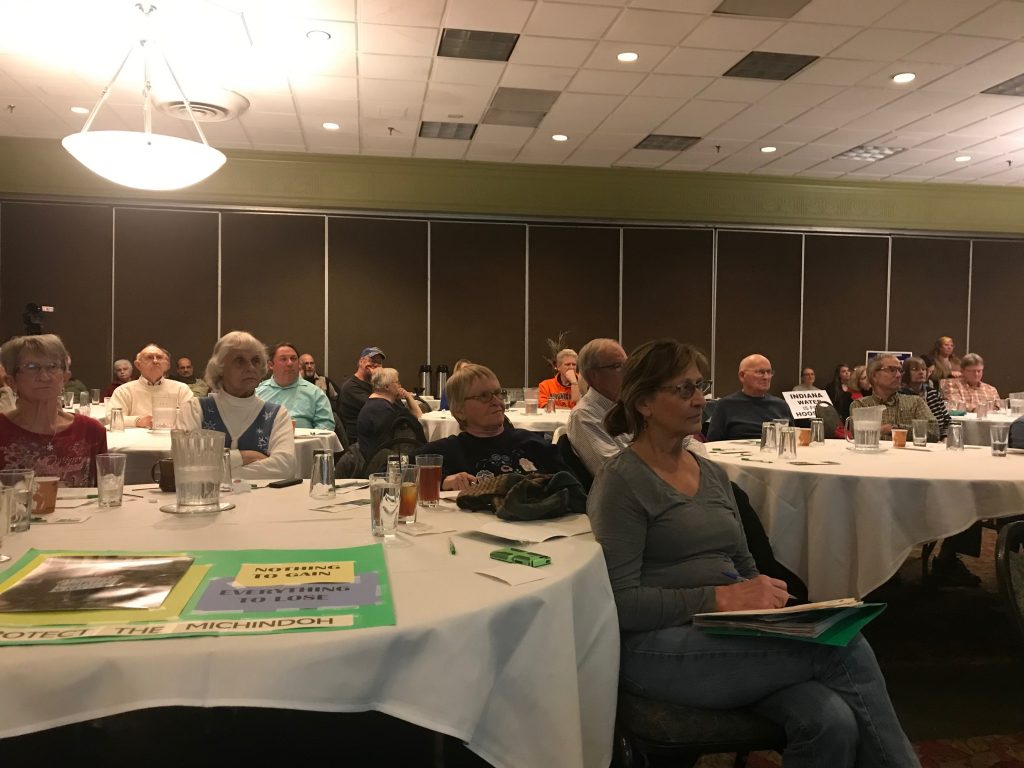By DAVID DUPONT
BG Independent News
No one brought a dowser’s rod to the meeting on finding a solution to regional water needs Tuesday night. PowerPoint presentations were the tool of choice.
The Northwestern Water and Sewer District hosted the Regional Water Informational Meeting at the Holiday Inn French Quartet in Perrysburg to inform officials and residents of some of the possibilities being considered to provide water to the district’s 6,500 water users in northern Wood County.
Three options were discussed, though several others exist.

The district’s search was prompted by the Toledo water crisis in summer of 2014, and then by the upcoming end in 2024 of the district’s contract with the City of Toledo to provide water.
Toledo is undertaking a massive rebuild of its water treatment system. It has invested $500 million already with another $300 million in planned spending, explained Rex Huffman, the district’s legal counsel.
Huffman discussed the ongoing negotiations about forming a Toledo Water Commission. The commission idea hatched in the wake of Toledo City Council’s rejection of another proposed joint entity the Toledo Area Water Authority. The authority, which would have included Toledo and eight largest entities, would have taken control of Toledo’s water system. City officials balked at the authority because of that, and fear that those who buy Toledo water would have too much control over the rates.
Under the commission, Toledo retains ownership of the plant and is responsibility for financing improvements as well as retaining ultimate control over rates. However, as Huffman explained, the commission would establish the rates, and then Toledo City Council would have final say. But in order to overturn the commission’s action it would take a super majority.
That arrangement, Huffman said, would result in uniform rates, long-term stability, and a regional approach to emergency management of water resources.
Commission would also provide a forum to explore redundancy in the water sources, so entities would not be left high and dry in the event of another water crisis.
“The dialogue between the city and the suburbs has never been better,” Huffman said. That was demonstrated by the overwhelming support for the commission by Toledo voters in November, he said.
Theodore Bennett, an engineer with Jones & Henry, discussed the possibility of Maumee, Perrysburg and northern Wood County communities getting their water from Bowling Green.
Bowling Green already sells water to Waterville. To extend it to the other 6,500 customers would more than double the demand on its water treatment plant. The current demand is for 7 million gallons per day. The new entities would have a demand of 11 million gallons per day. The plant’s capacity is 11 million, so an addition or new plant would have to be built.
New pipeline, including across the Maumee, would also have to be run to service these new areas, Bennett said. The entire project cost would be between $95 million and $130 million.
But how this would be structured would have to be decided. Would Bowling Green expand the plant, pay for it, and pass the costs along to the new customers? Or would the district fund new treatment facilities?
The initial feasibility study is scheduled to begin in January, he said.
Maumee and Perrysburg are also involved in the early stages of looking at the possibility of tapping into the groundwater in the Michindoh Aquifer, which extends under the western part of northern Ohio and into Indiana.
Tom Borck, an engineer with Poggemeyer Design Group, said that the interest in groundwater came from increased concerns about reliance on open sources of water and greater regulation on those sources.
The private firm Artesian of Pioneer has started testing to see how much water the aquifer holds. Borck said to date the testing has been positive, showing that drawing water would have minimal local users.
“The testing does show that the groundwater source is very robust,” he said.
The plan, however, drew the sharpest questions afterward.
Citizens who depend on the aquifer for water were on hand. They have pushed Bryan and Montpelier councils to express opposition and concern about the project.
The first written question posed to Borck, noted that the US Geological Service, has called for a 10-year-study of the aquifer. Borck responded that having 10-years worth of data would be great, but the use of modeling can develop the data in a shorter period.
“We need more information before a decision can be made to continue down this path,” he said.
Jerry Greiner, president of the water and sewer district, said several other options exist, including water from Lake Erie through Ottawa County or Oregon. Members of the district have access to the Maumee and Lake Erie, as well, he noted.
The district need not just take one option, but use different options for different areas. “It would take some re-engineering to the distribution system to work,” he wrote in an email this morning.
“The problem … is the cost and difficulty of breaking up the system that is in place of water towers and pump stations and getting large amounts of water to users such as First Solar and the new Pilkington plant.”





